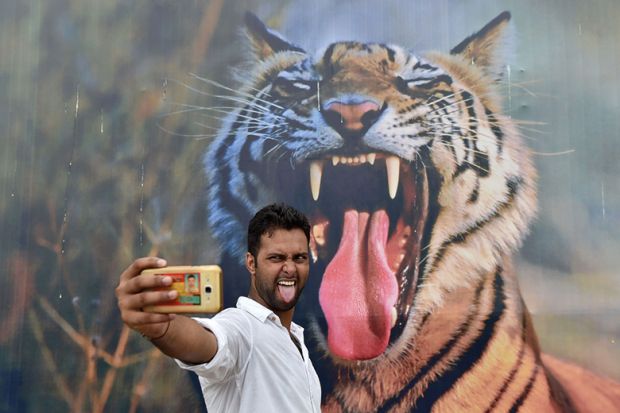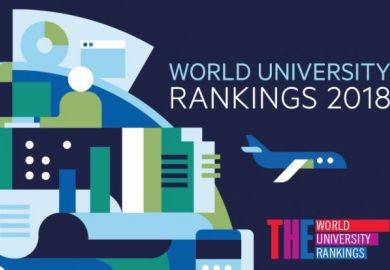Browse the full results of the World University Rankings 2018
A cursory glance at this year’s Times Higher Education World University Rankings can give the impression that developing countries have performed poorly. The true picture, however, is more nuanced, and it reveals some surprising vigour and promise in a number of areas, institutions and countries.
Brazil has only one institution, the University of São Paulo, in the top 400, down from two representatives in 2015-16; and it has a total of 10 institutions among the top 800, down from 12 last year. And although the World University Rankings are larger this year, just 21 Brazilian universities feature altogether, down from 27 last year.
India’s representation has also declined, from 31 institutions to 30, while eight of its universities have slipped to a lower band. The country’s flagship university, the Indian Institute of Science, has been demoted from the 201-250 cohort to the 251-300 band as its research income and citation impact have declined.
Eight South African universities still make the list, but the country’s two leading universities have both recorded significant declines: the University of Cape Town drops 23 places to 171st, while the University of the Witwatersrand falls out of the top 200, plummeting from joint 182nd to the 251-300 group. Both institutions received lower scores for their teaching reputation, their research reputation and their citation impact; together, these metrics account for 63 per cent of the overall score.
Meanwhile, six Russian universities fall out of the top 1,000, shrinking its total representation from 24 to 18. Its top-ranked institution, Lomonosov Moscow State University, slips six places to 194th, but Moscow Institute of Physics and Technology, Tomsk Polytechnic University and the Higher School of Economics have all climbed at least one band. Despite these improvements in the lower realms of the table, Russia is unlikely to reach its target of seeing five of its institutions in the world top 100 by 2020.
The THE World University Rankings 2018: results announced
China is the only BRICS nation that has advanced dramatically; it is now the fourth most-represented nation in the table, with 60 universities, including seven in the top 200, up from four last year.
Other emerging nations in Latin America and Eastern Europe have registered declines this year.
Part of this can be attributed to an increase in the number of universities participating in the rankings. Although this year’s table includes only 20 more universities than last year’s, about 1,500 institutions from across the world submitted data for consideration in the World University Rankings, up from 1,300 last time.
Overall, 111 universities in the top 1,000 are newcomers this year.
Indeed, much of the movement reflects genuine improvements for some rapidly developing higher education nations, particularly those in Asia, whose advances have caused other more vulnerable emerging countries to slip down the table.
Despite a gloomy picture for some of these economies, a close look at universities’ and countries’ scores in the pillars and individual metrics reveals the areas in which they are strongest and where they have greatest potential.
Teaching tends to be the pillar on which universities ranked between 201 and 1,000 perform most impressively, thanks to their history as primarily teaching-focused universities and their relatively recent adoption of strategies aimed at building research capacity.
Student-to-staff ratio, in particular, is an area in which many universities in developing nations outperform elite institutions in more established higher education countries. Excluding the medical universities, which tend to be high performers on this measure, Bauman Moscow State Technical University in Russia and King Fahd University of Petroleum and Minerals in Saudi Arabia, for example, are in the top 50 when judged on this indicator alone. In comparison, Harvard University ranks below the top 100, while ETH Zurich – Swiss Federal Institute of Technology Zurich is positioned outside the top 400.
In general, institutions in developing countries are held back when it comes to their reputation for teaching and their research and citation impact. Prestige takes many years to acquire and tends to be bestowed some time after the achievements it marks have been accomplished. This lag disadvantages newer and less advanced institutions, while research influence often correlates with high levels of research income and productivity, two metrics dominated by the world’s richest nations.
Universities in India, Russia, Algeria and Nigeria are among the institutions with the weakest citations scores in the table, for instance.
But some universities punch above their weight when it comes to research, overcoming their challenging funding and science environments.
Diego Portales University in Chile – the only Chilean university to have improved its rank (from 601-800 to 501-600) – is one such overachiever. Despite being one of the poorest performers in the table when it comes to its teaching environment, it is ranked 265th on citations, an impressive leap of 187 places since last year. It has also improved its research output and its research reputation.
Academics at the institution are given financial incentives to publish in international and prestigious journals, while its professors are encouraged to forge cross-border partnerships and to produce research that addresses pressing problems for wider society, says the university’s rector, Carlos Peña.
“We are convinced that the young universities in Latin America can innovate in the international research agenda…if they make efforts to link academic disciplines with the problems belonging to the civil society,” he says.
In fact, several institutions in Chile and Colombia achieve relatively high scores for research and citations compared with other emerging countries.

Daniel Ciocca, principal investigator at the Institute of Experimental Medicine and Biology in Mendoza, Argentina, argues that universities in these countries have “healthier” higher education systems than other nations in terms of their amount of funding from tuition fees and the government, their numbers of students and professors and the balance of financial support for teaching and research.
He contrasts this with the higher education landscape in Argentina, which has only one representative, the National University of Córdoba, in the 801-1,000 band.
Argentinian universities receive a relatively small amount of money from the government, and most of this goes towards researchers’ salaries and building maintenance, Ciocca says, meaning that research is “not the priority”.
“The system is not so different in the private universities,” he continues. “The students pay relatively low tuition [fees], not enough to support good research, and most of the funds go to maintain the teaching capabilities.”
In the Middle East and North Africa region, six Egyptian universities have improved their citation impact, and eight of the country’s nine representatives perform better on the citation indicator than they do in the overall table.
It is a similar picture in Iran. In fact, its top performer, Babol Noshirvani University of Technology, is ranked in the 301-350 band overall but is 14th for its citation impact.
In Eastern Europe, Estonia’s University of Tartu stands out when it comes to research quality. It is also ranked in the 301-350 band overall, but is 168th for its citation impact and has increased both its research output and its research income.
Volli Kalm, Tartu’s rector, says that reforms in Estonia in the 1990s led to the creation of a national science foundation and research council. This resulted in a change of research culture as academics had to sharpen up and compete for funding, and Tartu is now reaping the rewards, he says.
“The [funding] evaluation is based on publications and citations statistics, so for a quarter of a century academics have lived in a very competitive environment,” Kalm says.
Universities in Estonia are also more autonomous than some institutions in other European countries, he says, pointing out that institutions have full control over their properties and complete discretion over their funding, for instance.
“State regulations are rather minimal. That enabled us to establish a university development fund, which is used mainly for interdisciplinary projects or to hire new people from abroad,” Kalm says.
A study of higher education autonomy in 29 European countries, published by the European University Association earlier this year, found that Estonian universities enjoyed the most freedom when it came to independence around staffing (recruitment, salaries, dismissal and promotion of staff) and academic freedom (admission procedures, degree programmes and quality assurance).
- Pillars of excellence: the top 50 for teaching
- Pillars of excellence: the top 50 for research
- Pillars of excellence: the top 50 for industry income
- Pillars of excellence: the top 50 for internationalisation
The area in which many developing nations shine in the rankings is industry income, a measure on which quite a number of less heralded institutions outperform their counterparts in leading higher education nations.
In some cases, institutions may have had to seek out alternative funding sources to compensate for the low levels of central government support for higher education and research, meaning that they are more reliant on funding from businesses than their counterparts in richer countries.
In their higher education sectors, several emerging nations have placed great emphasis on science and technology disciplines to deliver benefits to their communities and, in some cases, to fast-track their performance; and as these subjects best lend themselves to industry collaboration, this could be another factor driving success on this measure.
Turkey’s Istanbul Technical University and Brazil’s Federal University of Itajubá, which is considered to be the country’s first technological university, share pole position in the table for industry income, for example. The Moscow Institute of Physics and Technology (MIPT) also does well.
MIPT has its own BioBusiness Incubator for developing corporate and faculty laboratories in addition to nurturing innovative small businesses. It is designed to be a “launching pad” for young, inventive entrepreneurs, according to the university.
But while the institution has improved in terms of its industry income, as well as in the areas of teaching, research and citations, its strength on the international outlook indicator has waned, reflecting a drop in the number of its international publications.
Vitaly Bagan, MIPT’s development director, says that internationalisation is a priority at the university.
In particular, the institution is focusing on collaborating with global partners, creating and launching international educational programmes taught in English, and attracting a large number of foreign students, he says.
Recent government changes allowing PhD researchers to defend a thesis in a foreign language will also enable the country to significantly boost its number of international postgraduate students, Bagan adds.
“We are participating in various international programmes supported by the Ministry of Education and Science of the Russian Federation, such as [the European Union’s mobility scheme] Erasmus+,” he explains.
“More than 130 postgraduate students from the CIS [Commonwealth of Independent States] countries and all over the globe – from neighbouring Belarus and Kazakhstan to Italy and even Mexico – are studying at MIPT now.”
Meanwhile, Bagan points out, 45 per cent of the university’s scientific papers are published with international co-authors.

Download a copy of the World University Rankings 2018 digital supplement
Despite its position as one of the leading developing countries in the World University Rankings, India is one of the worst performers when it comes to internationalisation.
While most of its universities have improved on the three international metrics – international students, international staff and publications – all bar one have dropped places when ranked on this pillar because they have been surpassed by other universities rising at a faster rate.
Matthew Hartley, professor of education at the University of Pennsylvania’s Graduate School of Education, says that government policy strictly limits the number of students from abroad who may study in India and prevents international scholars from being hired into long-term faculty positions.
“This is because the government covers the vast majority of operational expenses – therefore higher education for Indian students is a priority,” he explains.
“At the institutional level, many leaders I’ve spoken with have talked about the value of having voices from other countries and contexts at their institutions, and there seems to be a great desire to see these policies amended.”
There is a possibility that these wishes could come true for the country’s leading research institutions when the government’s “world-class” university strategy is implemented.
The scheme aims to identify some 10 public and 10 private universities to receive significant government funds for investment in infrastructure and academic staff. It follows similar “excellence initiatives” in China, Japan, South Korea, Taiwan and Singapore.
Hartley, who is working on a major study exploring how nations including Kazakhstan, Vietnam, Singapore and India have sought to establish world-class universities, says that it is too early to judge the programme’s potential success because the legislation is still winding its way through parliament.
But “one promising aspect” is that it creates a cohort of institutions that will “all be grappling with institutional change at the same time”, Hartley says. “In short, the institutions selected can learn from one another and support one another as they figure out how to strategically invest funds to produce better learning for students and to increase research productivity.”
Although China remains the leading and fastest-rising developing country in the rankings, Hartley believes that India has “great potential to be a key global player in higher education in the coming years”, despite its lag in internationalisation.
“It has many first-rate institutions, some with selectivity rates greater than those of any institution in the US. Instruction at these institutions is in English, which is an advantage. India would also be able to offer instruction at lower costs than many other countries,” he says.
“But India will also need to address the needs of its own people. The number of outstanding applicants to India’s best institutions exceeds the number of places available for them to a staggering degree. So, it’s going to be important to increase the number of institutions providing exceptional education.”
Register to continue
Why register?
- Registration is free and only takes a moment
- Once registered, you can read 3 articles a month
- Sign up for our newsletter
Subscribe
Or subscribe for unlimited access to:
- Unlimited access to news, views, insights & reviews
- Digital editions
- Digital access to THE’s university and college rankings analysis
Already registered or a current subscriber? Login





